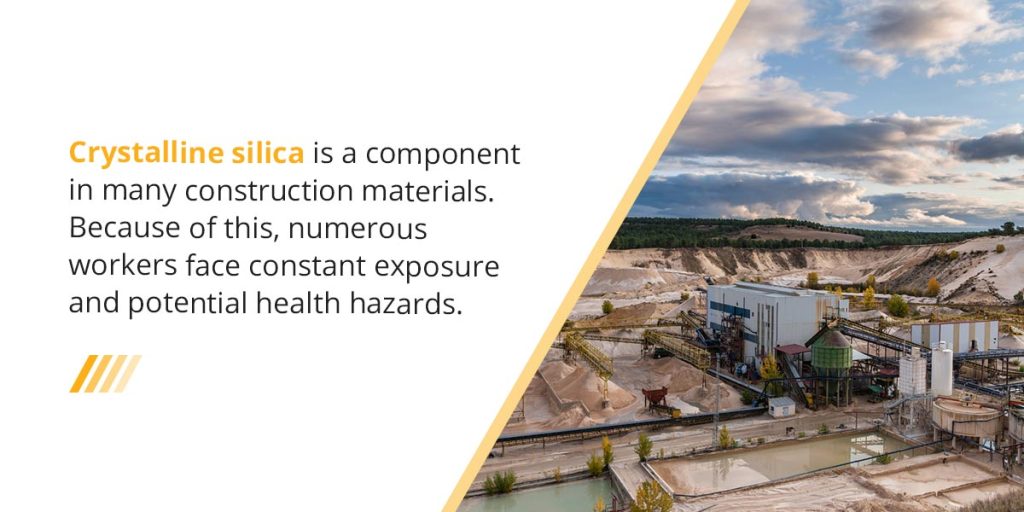Exposure to crystalline silica has long been known to cause potential health risks in humans. OSHA has standards with reduced permissible limits to further protect workers’ exposure to respirable silica.
Finishing Systems takes the safety and health of our employees seriously and you should too. We strive to keep our valued customers abreast of changes and developments affecting our industry.
If you have any questions or would like more information on the revised silica standards, we encourage you to visit OSHA’s website, or you can use their On-Site Consultation Program for professional guidance. This program helps you identify and reduce the risk of silica and other hazards in your workplace.
The two new standards cover:
While the standards for construction workers have been in effect since September 23, 2017, provisions for general industry and maritime workers took effect on June 23, 2018. These new standards apply to workers in contact with loose silica products — for blasting, abrasion, foundry, etc. — as well as those who perform tasks that create airborne silica from solid materials, such as stones, masonry, concrete, stones, bricks and others.
Crystalline silica is a mineral from Earth’s crust. It’s commonly found in construction materials like sand, stone, concrete and mortar. Workers also use crystalline silica in products like glass, pottery and ceramics.
The mineral is available in many forms, including:
When employees grind crystalline silica into tiny particles, it can travel into their lungs, creating breathing problems and leading to diseases.
Respirable silica is silica dust that humans can inhale. It is at least 100 times smaller than a typical grain of sand. Many construction and industry activities can create this fine dust when working with stones, brick, mortar and other silica-containing materials in ways such as:
Abrasive blasting, hydraulic fracking and foundry work can also create respirable silica. Once liberated into the air, unprotected workers risk inhaling the crystalline silica, which can lead to increased incidents of several silica-related illnesses, including:

Crystalline silica is a component in many construction materials. Because of this, numerous workers face constant exposure and potential health hazards. As workers complete common construction work tasks, the crystalline silica turns into respirable silica and enters their lungs.
Tasks like these could expose construction workers to crystalline silica:
OSHA estimates over 600,000 workplaces are exposed to respirable silica each year. Employee exposure to crystalline silica can lead to severe health issues, so OSHA has developed safety standards to limit the effects and keep workers safe.
OSHA standard 1926.1153 addresses respirable crystalline silica exposure. It requires employers to limit worker exposure to silica and enact protective measures when exposure is unavoidable. Supervisors must follow OSHA control methods or independently design dust control measures. All workplaces with crystalline silica must adhere to the permissible exposure limit (PEL).
Table 1 in OSHA’s respirable silica standard outlines various construction processes and the accompanying dust control methods. Employers should use the table for guidance on exposure protection.
For example, one task on the table is operating a saw outdoors. The OSHA standard states that if an employee uses the saw outside for four hours or less, they wouldn’t need a respirator. But if they worked for more than four hours or indoors with the saw, the employee would need a respirator or additional protective elements.
Alternatively, employers who don’t use Table 1 are required to determine the amount of silica exposure and enact protective elements. They must use dust control methods to keep workers safe and provide respirators.
OSHA’s standard also requires all construction employees to:
More than 2 million Americans are exposed to silica throughout their careers. If proper protections aren’t used, workers are at risk of silica inhalation. Solutions to crystalline silica inhalation can include:

Here at Finishing Systems, we take the health of our employees and customers seriously. We have recently conducted monitoring and professional testing for our workplace.
Please contact us for safety equipment and supplies to ensure that your company and its employees are properly protected. We have an extensive line of safety products to help you protect the most valuable assets in your workplace — your workers!